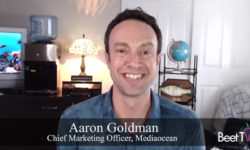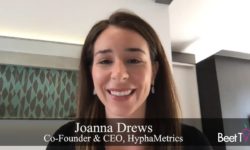Amid the coronavirus crisis, many ad buyers, deeming the news too negative to appear next to, are adding virus-related keywords to brand safety tools that let them automatically filter the hottest news story of the day out of their media plans.
That is kneecapping the revenue of many news publishers at a precarious moment, and threatening to make many brands invisible. But Linda Utzschneider thinks it doesn’t have to be this way.
The CEO of Integral Ad Science (IAS) – a vendor of brand safety, viewability, ad fraud and other software – says some such tools allow more refined control than simply blocking keywords.
“We absolutely do not advise completely blocking the news category,” Utzschneider says in this video interview with Beet.TV. “We work with marketers and say, ‘Hey, you know what? We could actually, based on the sentiment of the content, be able to segment out content that’s more positive or hero-related content tied to coronavirus’.”
More meaning with semantics
Rather than simply blacklist all stories about “coronavirus”, for example, Utzschneider advocates a deeper inspection of what kinds of pandemic stories may be good placement opportunities.
That alternative comes at the intersection of brand safety lists, with tools that can peer deep in to the inner meaning of content, making them available as richer indicators.
In her case, that means ADmantX, which IAS acquired in November, whose semantic analysis software aims to create, from stories, corresponding flags for emotions and sentiments, plus for entities contained in stories, which can be leveraged by media buyers and sellers.
“We’re able now, through machine learning and AI, to do page-level analysis, get down to the content, the context of the page, and then also the sentiment of the content,” Utzschneider adds.
“With all of those different layers, we’re able to offer a precision technology for advertisers so they can really think through and plan for the type of content they want to be adjacent to, in particular related to coronavirus.”
We’re proud to partner with @AdCouncil to share public service announcements about stopping the spread of COVID-19. Thanks to @martyswant @Forbes for covering this important initiative. https://t.co/aJqFsBo1g3
— Lisa Utzschneider (@Lisa_Utz) April 1, 2020
Keyword controversy
Last week, Comscore, announcing its own “epidemic brand safety filter” that lets ad buyers swerve virus news, said 22% to 30% of all ad impressions were appearing in coronavirus-related content.
Traffic to news sites is booming. But many advertisers are pausing on news sites, whilst coronavirus content specifically is now being widely blacklisted by ad buyers, amid consternation that all kinds of virus news are falling on the negative side of “brand safety” definitions.
IAB and Digital Content Next have called on advertisers to cease the practice.
In one of latest news reports on the matter, The Wall Street Journal says half of all desktop and mobile ad impressions across news sites in its Dow Jones family stable were being deemed unsafe for brands to advertise against by Oracle-owned Moat, an IAS competitor. The paper also quotes another such vendor, DoubleVerify, as urging advertisers not to block such keywords on trusted news sites.
In a blog post, IAS said keyword blocking is at the discretion of advertisers and their agencies, advising against “a blanket approach or overzealous use of keywords”.
Speaking with Beet.TV, John Montgomery, the brand safety EVP at the world’s largest media-buying agency, GroupM, urged ad buyers to use enhanced features of such tools rather than bluntly blocking, because news is n effective channel in which to be seen.
https://twitter.com/integralads/status/1240415295862460416
Results of a survey published this week by Utzschneider’s IAS show:
- 58% of users are actively seeking out coronavirus news.
- 78% say their sentiment toward a brand placed in coronavirus news remains unchanged.
- But consumers believe the suitability of that placement depends on the brand.
- They have greater demand for messaging from health, pharmaceutical and government communicators.
- Travel and food-and-beverage ads are the biggest turn-offs for consumers right now.
Beet.TV has been following the topic:
- Digital Will Accelerate Through V-Shaped Recession: Sorrell
- Bluntly Blocking COVID-19 Keywords Is Not Right: GroupM’s Montgomery
- Pause Ads & Be Helpful During Outbreak: Forrester’s Nail Advises
- Don’t Block Virus News: IAB’s New President Warns Advertisers
- Covid-19 Shows Social Networks Can Fight Misinformation: eMarketer’s Enberg
- How Virus Will Hit Ad Spending: SMI’s Fennessey
- Comscore’s ‘Epidemic Safety Filter’ Lets Brands Opt Out Of Virus News: Gantz
- Nielsen’s Bradbury: Consumption Won’t Trail Off Due to Coronavirus, but It Will Change
- Crises Are A Test Of Brands’ Soul: GroupM’s Norman
- Brands Can Be Useful Through Virus Crisis: GroupM’s Wieser
This interview was conducted remotely, using Zoom.














































